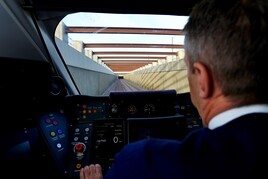Rail Minister Chris Heaton-Harris officially opened the new Werrington Grade Separation and its dive-under on December 9.
Located north of Peterborough station, the dive-under carries freight trains underneath the busy East Coast Main Line (RAIL 944).
The original flat crossing was a major hindrance to putting more trains on the ECML. The new facility removes the conflict between long-distance high-speed passenger services and freight trains that had to cross all lines of the ECML between Peterborough station and Werrington Junctions to gain access to the Great Northern/Great Eastern Joint Line.
It is deemed to be a crucial part of the £1.2 billion upgrade of the East Coast Main Line, improving the reliability and punctuality of inter-city passenger journeys while providing an extra 38% capacity that equates to an additional 2,900 to 3,950 seats per hour.
“Opening this new section of railway marks the end of a project which saw Network Rail engineers deliver an incredible feat installing an 11,000-tonne concrete tunnel, freeing up tracks and unlocking new opportunities for rail freight,” said Heaton-Harris.
To read the full story, see RAIL 947.















Login to comment
Comments
Güntürk Üstün - 15/12/2021 07:32
Werrington Dive Under (also known as the Werrington Grade Separation) is a replacement dual track grade separated railway junction at Werrington Junction, 3 miles (5 km) north of Peterborough railway station in Cambridgeshire, England. The junction leads to the Great Northern/Great Eastern Joint line (GN/GE) which goes through Spalding to Lincoln and beyond. Finished and opened almost a week ago, the dive under allows trains on the west side of the East Coast Main Line (ECML) to access the GN/GE line without conflicting with the faster passenger services on the ECML. The completed project will help pave the way for the massive infrastructure roll out across the North and Midlands recently announced in the Integrated Rail Plan (IRP). The IRP sets out £96 billion worth of investment into the railways that will deliver real and meaningful improvements to communities, supporting economic growth by transforming both East–West and North–South links. The IRP will bring benefits more quickly to more places, many of which would have gained little under previous plans. Dr. Güntürk Üstün